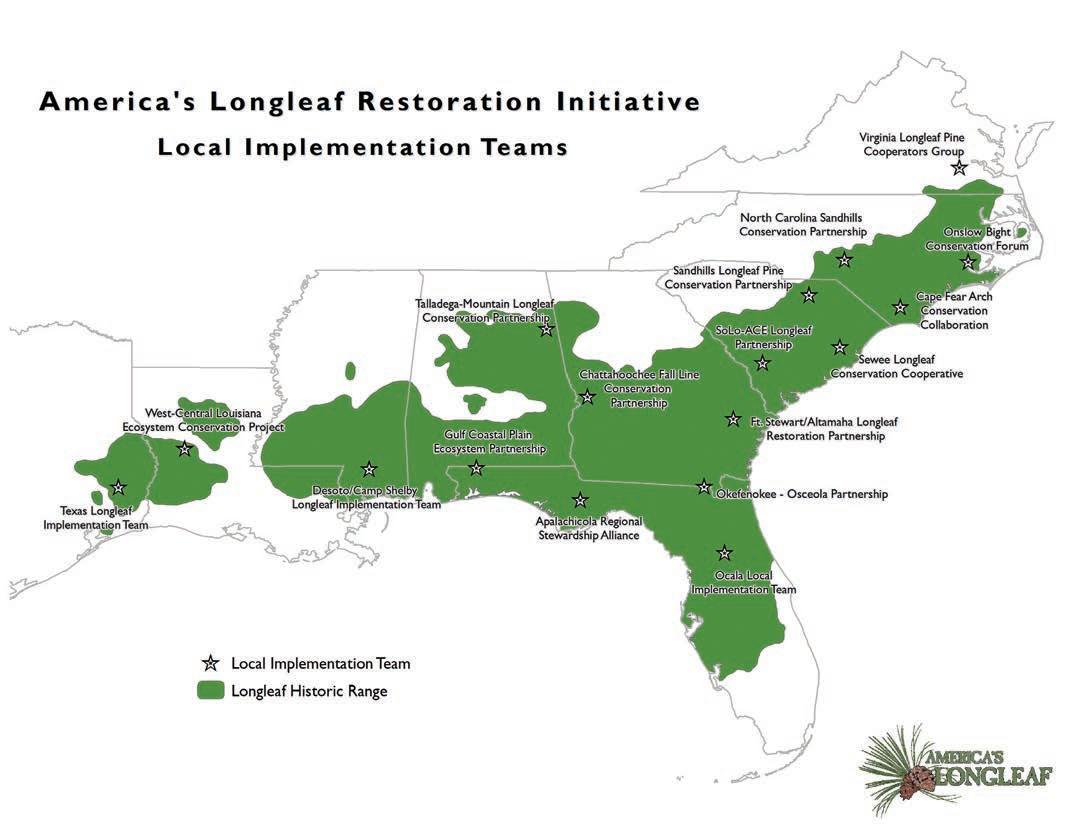
10 minute read
Longleaf Destinations
View of the Birmingham skyline from the old quarry at Ruffner Mountain Nature Center. Photo by Kelly Verdeck.
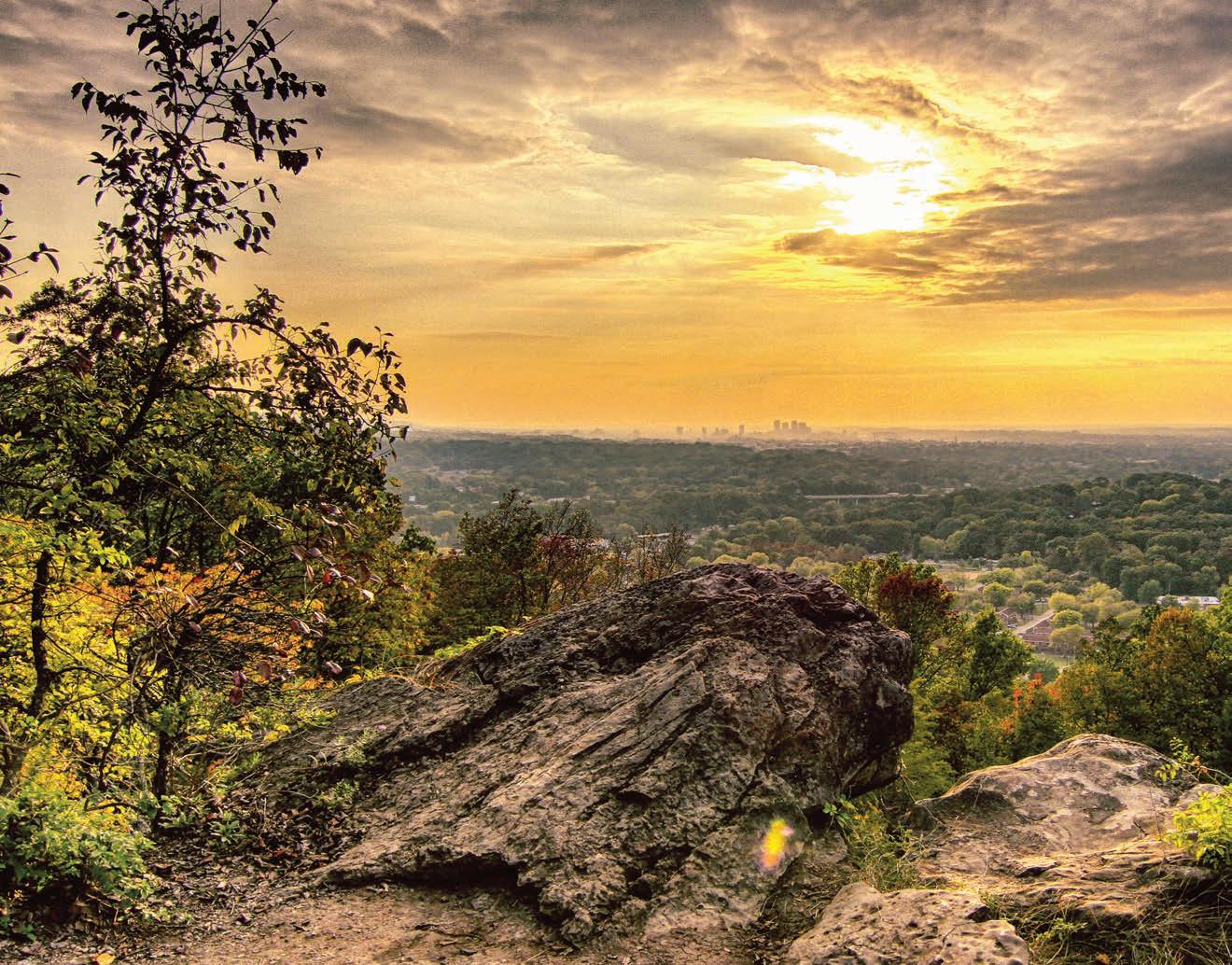
Advertisement
Longleaf with a View — Remnants and Restoration of Montane Longleaf Near Birmingham
Alabama’s original forests were very different from what we see today – dominated in much of the state by vast expanses of longleaf pine forests and their unique and desirable plant and animal species. In every region of the longleaf range, these forests were largely consumed during our development as a nation. What older timber remains is a fraction of once was, but Alabama is a leader in restoring longleaf from the coast to the mountains. Montane longleaf is different from coastal plain longleaf in more ways than just the elevation. The tree and the natural plant communities are adapted to their more arduous environment, though many parts of the forest community are familiar. While longleaf pine once extended over a vast area in the Southeast, only in Northeast Alabama and Northwest Georgia did these forests extend beyond the Coastal Plain, through the Piedmont, and into the Blue Ridge Mountains. While Coastal Plain longleaf pine commonly occurs on a variety of soils, the mountain longleaf pine forests grow on steep rocky slopes and along upland ridges. They are considered the most endangered of the remaining longleaf pine communities. Located in the north-central part of Alabama, with mountains prominently framing the surroundings, Birmingham offers a central base and a wide variety of diversions near many splendid mountain longleaf sites. The most extensive metropolitan area in the state with a population nearing 1.2 million, it serves as a regional transportation hub for the South. Arguably the state’s cultural and entertainment capital, with many notable museums, galleries, diverse dining, sporting events, and historical sites, the city has transformed into a
It is hard for landowners to consider a choice they have never seen or even knew existed. Since there was no existing guide for montane longleaf sites, the U.S. Forest Service and The Longleaf Alliance, with input from the Talladega Mountain Longleaf Pine Conservation Partnership, developed an interactive virtual tour showcasing the natural and historic treasures of ten montane longleaf sites surrounding Talladega National Forest.
In this preview, we share a few of the featured sites from the project. We invite you to explore the full tour online – you can find it by visiting longleafalliance.org.
When exploring on foot, please respect all posted signs and rules for each site, aiming to leave no trace and take only pictures. Many sites on this tour route are remote and, at times, beyond the range of cell phone signals. Know before you go – check current restrictions or status with the managing agency as you plan your trip.
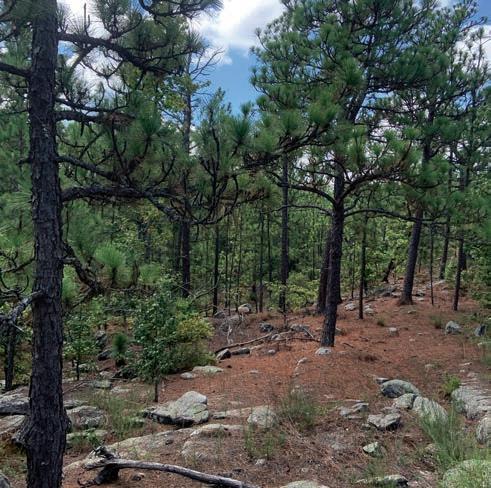

A. B.
A. Longleaf on a rocky slope at Oak Mountain State Park. Photo by Lauren Muncher. B. Planted longleaf pine seedling in a stand damaged in the 2016 wildfires near Lake Chinnabee. USDA Forest Service photo by Ryan Shurette.
banking and business hub and a higher education center.
Birmingham was founded during Reconstruction in 1871 as an industrial center built on mining, iron and steel production, and the necessary railroads for transport. All of those industries were, in turn, heavy consumers of the surrounding natural longleaf resources. With the decline of the mining and steel industry in the latter part of the twentieth century, multiple mining properties have been transformed into outdoor recreation opportunities. At Red Mountain Community Park, relict trees provide a glimpse into what was once there, and at Ruffner Mountain, initial longleaf restoration efforts provide a glimpse into what could be.
Whether you enjoy hiking, biking, birding, rare plants, hunting, camping, or simply taking a dip in a cool lake on a hot day, the longleaf pine destinations near Birmingham offer healthy adventure and an introduction to some of Alabama’s beloved and amazing natural diversity.
Oak Mountain State Park
In the foothills of the Appalachian Mountains, you will find the largest and one of the most biodiverse state parks in Alabama. Initially established by the Alabama State Lands Act of 1927, Oak Mountain State Park has grown to 9,940 acres and is home to some incredibly important flora, including longleaf pine. This park has a rich history, with countless hours spent by the Civilian Conservation Corp building this beautiful recreation area. Many trees growing in the park were
Montane longleaf at Coosa Wildlife Management Area, one of ten sites featured in the “Guided Tour of Alabama's Longleaf.” Photo by Mark Bailey.
The virtual tour showcases ten montane longleaf sites (see red marker locations) surrounding Talladega National Forest (shown in green) within the Talladega Mountain Longleaf Conservation Partnership.
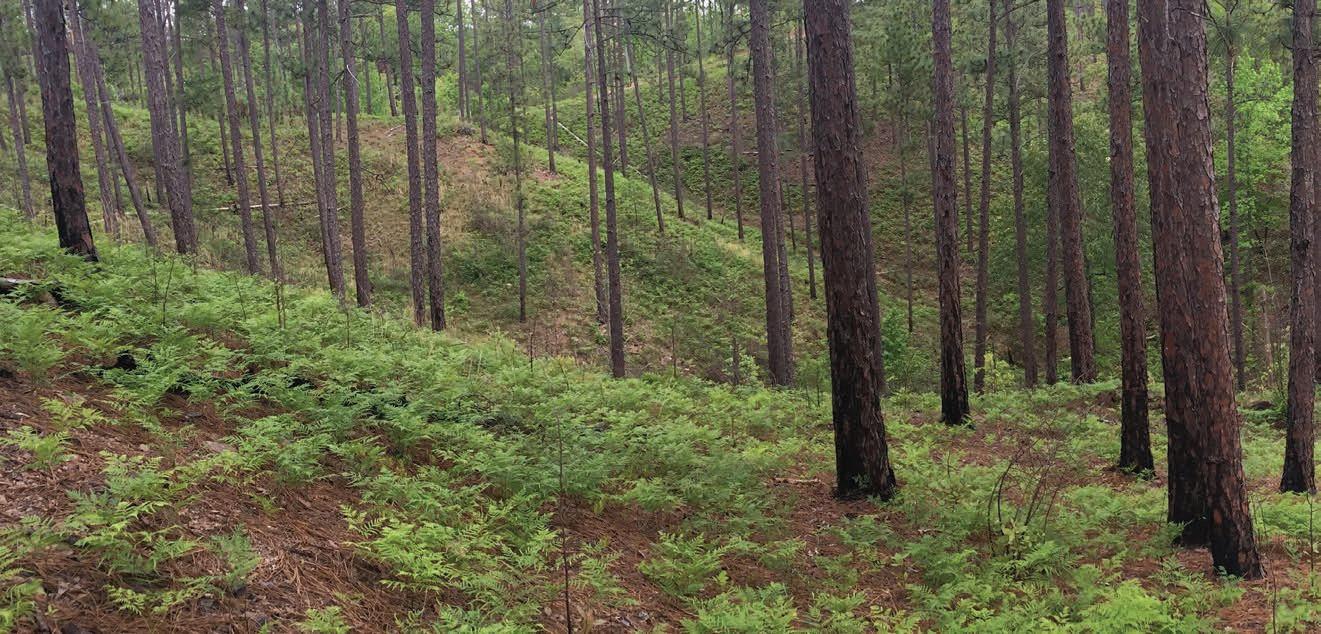
used to construct cabins and other structures, but luckily many (2,407’). The hard and tireless work of decades of restorative efof the longleaf were spared. forts is visible on Cheaha State Park’s trails and the surrounding
The longleaf pine habitat found throughout Oak Mountain Talladega National Forest. Although Cheaha State Park contains is considered montane forest and is one of the largest remain- only a small community of longleaf, it is surrounded by the Taling in the state. Some of the pines here are over 100 years old ladega National Forest’s rolling green ridges and valleys, encombut appear younger due to passing over 300,000 acres of slow growth in these thin forests. Since this surrounding soils and rocky terrain. At area was historically occupied one time, this longleaf habi- by longleaf pines and naturally tat supported red-cockaded experienced frequent fires, park woodpecker populations and staff are in the initial stages of some of their old cavities can re-introducing fire back into still be seen today. As part of the forests. a planned restoration effort, Some of the largest, oldest the park will soon re-intro- longleaf pines in the park can duce controlled burns into be viewed on the Lake Trail, the longleaf forests. This will which connects Cheaha Lake significantly improve the to Rock Garden. This 1-mile health, biodiversity, and trail is steep and rugged, makbeauty of the forest and re- ing it fun and challenging; store habitats that, in time, just be sure you have proper can again provide homes for footwear for tackling this adthe red-cockaded woodpecker venture. and other important long- A primary focus of the park gleaf-dependent species. is to maintain healthy and nat-
The best access to view longleaf pine in the park is the 2.4- ural forests, creating crucial habitat for numerous plants and mile North Lakes Connector Trail, serving both hikers and animals while supporting great outdoor recreation opportunimountain cyclists. As you hike up the mountain, you will see ties. Cheaha Lake’s day-use area offers picnic tables, grills, larger stands of pines. There is plenty of parking with rest- bathrooms, swim beach, playground, and hiking trails. There rooms and a changing room at the trailhead and a modest $5 is also a lodge, restaurant, campground, and other amenities entrance fee for adults and $2 for children. in the State Park, making it a great place to stop, explore, or utilize as a home-base for exploring surrounding natural areas. Cheaha State Park Cheaha State Park charges a day-use fee, ranging from $2 to
Located in the middle of the Talladega National Forest, $5 depending on visitor age, with free entry for veterans, active Cheaha State Park takes its name from the Creek word meaning military, and children under three years. “high place” and is the highest mountain summit in Alabama
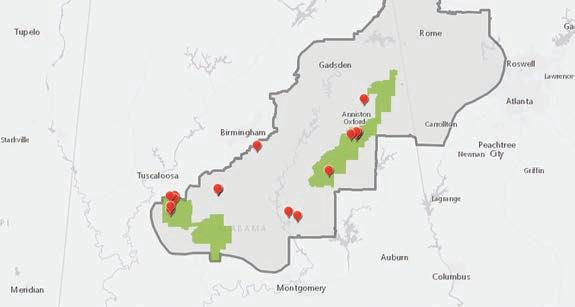

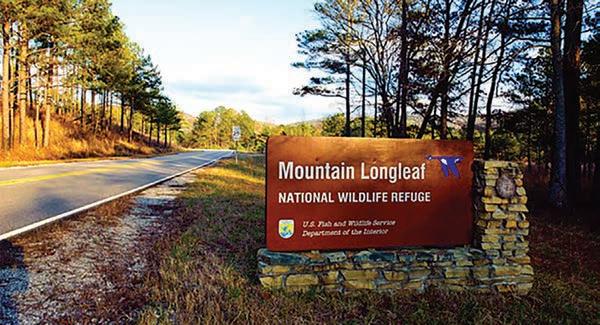
s
s
Entrance Sign to Mountain Longleaf National Wildlife Refuge. Photo courtesy of fws.gov. Remnant longleaf pine along a hiking trail at Cheaha State Park. Photo by Mandy Pearson.
Mountain Longleaf National Wildlife Refuge
Mountain Longleaf National Wildlife Refuge protects the largest stand of mature longleaf pines north of the state’s coastal plain. This Refuge was legislatively established on May 31, 2003, within the former military training base of Fort McClellan – which closed in 1999. On October 23, 2003, additional property was added to the Refuge, bringing the total to 9,016 acres of property.
You will find many unique habitats within the Refuge, such as spring seeps and hardwood bottoms, with longleaf pine forests dominant across much of the landscape. There are existing stands of old-growth longleaf pine as well as naturally regenerated second-growth forests where the herbaceous ground layer, in many situations, is intact and comprises an extremely diverse native fire-adapted plant cover. There is no record of tree planting ever occurring within the Refuge, so genetic contamination is not an issue, making this site incredibly unique. Additionally, fire has continually been a part of the landscape under Army ownership for the previous hundred years. Refuge staff are reintroducing fire back into the forests where it was absent.
It’s important to note that about two-thirds of the Refuge is closed to the public because of ongoing remediation from the former Fort McClellan. The unexploded ordnance (UXO) removal is still in progress, so you will likely see contractors out while driving on the Refuge. The area to the west of Ridge Road is closed to the public. Area closed signs are posted and easy to find along the boundary of the closed areas. When UXO cleanup is completed in the years to come, the remainder of the Refuge will be open to the public.
Unfortunately, none of the large longleaf stands are currently accessible due to the UXO closures. Even so, great views of this Refuge’s longleaf forests can be seen from the road. The best view of a mature forest can be seen on Bains Gap Road as you drive through the heart of montane longleaf country. Lake Chinnabee
Cheaha State Park is not far from the Lake Chinnabee Recreation Area in the Talladega National Forest; Cheaha Creek feeds this 17-acre lake. The recreation area offers facilities, hiking, picnicking, and fishing. Upstream from the picnic sites, the Chinnabee Silent Trail winds beside Cheaha Creek and ends six miles away at Caney Head atop Talladega Mountain. It is popular because of the spectacular views of flowing streams, rock outcroppings, and waterfalls.
Coming into Lake Chinnabee, along the paved entrance (Forest Road 646), you will see lots of mature longleaf on both sides of the road. Some of the longleaf is mixed with other upland hardwood species like chestnut oak and pignut hickory. In 2016, a large wildfire fueled by windy conditions and a severe drought occurred just to the north of Lake Chinnabee, and the effects are still very evident.
Torched stands of longleaf and loblolly timber are visible along the Lake Chinnabee entrance road and County Road 42. These timbers are a prime example of how catastrophic wildfires impact the forest canopy. Still, it is also a testament to the resiliency of fire-adapted plants and animals in longleaf forests. As part of a restoration effort, the USFS has underplanted many fire-killed timber areas with containerized longleaf seedlings to get a jump-start on the next generation of longleaf forest.
Lake Chinnabee is open to the public from March 1st through December 1st with an admission fee of $3 for day use only. There is no fee to view the post-wildfire longleaf recovery areas since you do not have to enter the official recreation area.
Thank you to the U.S. Forest Service for funding the development of “A Guided Tour of Alabama’s Longleaf” and the numerous organizations within the Talladega Mountain Longleaf Conservation Partnership who shared site recommendations, supporting data, narrative, and photos.








